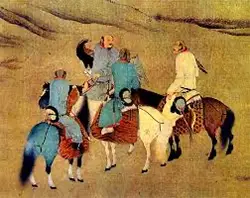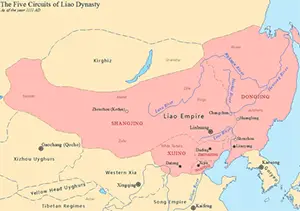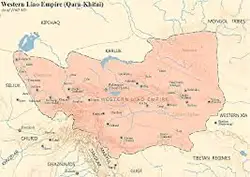China's Liao Dynasty
The Liao Dynasty ruled what is now northeast China concurrently with both the Tang and Song dynasties. Liao influence in the region lasted more than two centuries. 
Growing out of the tradition of the Khitan, who were known to Chinese people as far back as the Northern Wei Dynasty, in the time of Northern and Southern Dynasties, the Liao became a strong force in the wake of the demise of the Tang Dynasty, in the early 10th Century. The Khitan ruler Abaoji took the name Khaghan in 907 and a few years later took a Chinese name, Shenze, for his reign. At that time, he ordered built a capital city, which Chinese people called Huangdu. Abolishing the electoral tradition, Abaoji proclaimed a hereditary system of leadership and held on to power for more than two decades. A system of slavery powered the economy of the hereditary Khitan lands; in captured territory, the feudal system reigned. It was all part of a dual-government scheme that had different treatments, practices, and even laws for people in different parts of the empire. In 938, Khitan forces took control of Nanjing and the rest of the Sixteen Prefectures. Not a decade later, the forces of Liao, as they were eventually known, had reached the Huang He and occupied Kaifeng, later capital of the Northern Song. The 1005 Shanyuan Treaty, requiring Song to pay tribute to Liao, ended this struggle, for a time. In its wake came robust trade–with Song China and with other neighboring civilizations. About the same time, the Liao, under Emperor Shengzong, concluded another victory, over the Korean state of Goryeo. 
The Liao had, at its height, not one but five capital cities: one at each of the four main points of the compass and one in the middle; Liao emperors would hold court at each capital city throughout the year. The middle one is perhaps the most famous: It was Nanjing, what is today Beijing. Despite the trappings of rule, such as imperial palaces, Liao emperors sometimes reverted to their nomadic past and stayed in elaborate tents. The Jurchens lived under the yoke of the Liao state for many years before rebelling against them. The tribal chieftain Aguda in 1115 declared himself and his people free from Liao influence and resolved to fight to prove it. Aguda, as the leader of the new Jin Dynasty (often called the Great Jin Dynasty, to differentiate it from the earlier Jin Dynasty), and his people fought the Liao for a time and then gained a powerful ally, the Song. That alliance was powerful enough to drive Emperor Tianzuo and the Liao forces to the west, leaving the Jin in control of the north. 
The Liao people moved westward and became the Western Liao, carrying on their traditions for a time, until they were conquered by another, fiercer, foe. The venerable Genghis Khan led a Mongol horde of 50,000 against Western Liao forces in 1211. The Mongols reigned supreme. Liao culture strongly mirrored Chinese culture. Abaoji was enamored with Confucius and created an imperial academy to impart that philosopher's teachings. At the same time, the first Liao emperor ordered his people to create their own written language, to maintain their culture. Buddhism and Taoism found followers in Liao society as well. One demarcation between Chinese and Liao society was in the latter's granting of certain rights for and privileges of women. Khitan culture provided for women to learn how to hunt and how to manage not only a homestead but also a family property. Khitan women had the right to divorce–something far advanced of their Chinese counterparts. |
|
Social Studies for Kids
copyright 2002–2024
David White




